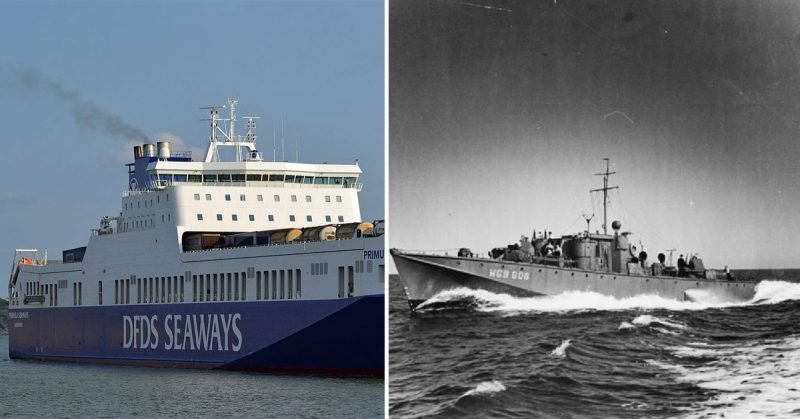Two vessels, the Peggotty and Petunia Seaways were involved in a collision that took place in the Humber estuary.
Peggotty (previously Maid of Galloway) was still seaworthy and operating as a general service launch when she was put up for sale. Commissioned by the RN Service Corporation in 1944, she was used as a training vessel after the war and was later sold to the Board of Trade. Her original engines were still in use.
What started off as an exciting voyage, ended in disaster. The vessel ended up wandering into the Humber estuary – the UK’s busiest – at 4 am. From Grimsby, they were bound for Hull, in order for the boat to be surveyed before the sale could take place, as the previous survey had been done twenty years before.
The voyage ended in a way neither Captain or passengers could have imagined.
At the helm was 34-year old David Carlin, an experienced off-duty harbor pilot, employed by Associated British Ports. With him was the purchaser’s representative carrying an iPad which was to be used to aid in the navigation. The passenger was confident that Carlin would be able to navigate safely out of the estuary as his job as a pilot made him an expert on the local waters.
On the morning of the 19th May, the estuary was blanketed in thick fog, but the skipper and the purchaser’s representative were both convinced that they could motor out safely. Confidently, they cast off but when the WiFi signal disappeared the iPad wouldn’t respond. There was no compass, a faulty radar system, and no navigation lights. The missing GPS data card meant that local charts stored on the iPad could not be used, and because there were no dividers or other instruments necessary for plotting a course, an ordinary paper chart could not be used either.
Skipper Carlin was unaware that Peggotty had strayed into the main shipping lanes of the busiest estuary in the UK, the Humber.
Early that same morning just after 4 am, a 60-year-old Danish skipper was in command of the cargo ferry, the DFDS Petunia Seaways, and was sailing down the Humber estuary towards Grimsby. She weighed in at 32,289 tons and was 1,400 times bigger than little 50 ft Peggotty.
At Grimsby Dock just before 5 am and less than an hour after leaving port, the Peggotty collided with the bow of the enormous ferry and then scraped down the port side of the 200-meter-long Petunia Seaways. Chaos ensued. Thankfully Peggotty’s life raft was at hand, and those on board were able to scramble to safety on the life raft. Carlin sent out a Mayday call at 05:00 BST, which was responded to by a nearby boat that rushed to their rescue. A lifeboat appeared on the scene shortly afterward and took charge. In less than 30 minutes there was no sign of the Peggotty, she had sunk to the bottom of the Humber estuary. For those who had been on board, it had been a very narrow escape which could have resulted in the loss of their lives.
An inquiry held by the Marine Accident Investigation Board as well as the Maritime & Coastguard Agency’s Hull Marine Office took place to find the reasons for the loss of Peggotty. Both the skippers of the Peggotty and the Petunia Seaways, were fined £3,000 for their negligence and ordered to pay costs. Both skippers were severely criticized for their behavior that morning. The skipper of the Petunia Seaways for allowing his vessel to proceed at 14 knots in zero visibility, not blowing his fog horn and for not paying sufficient attention to his radar, and Carlin for allowing the Peggotty to stray into the commercial shipping lane and for being completely blind at the time.
Carlin was then suspended from his pilot’s job even though he had not been on duty at the time. Surprisingly, the Danish skipper had been oblivious of the collision and had continued on his way, The Sun reported.
Those interested in the loss of the Peggotty thought the little boat that saved lives at Dunkirk had been sent to a watery grave, but it was not so. Little Ship Peggotty is one of the now-famous motor yachts that performed such wonderful life-saving rescues of troops stranded on the beaches of Dunkirk. Commander J Glendinning RNR on 5 June 1940 sailed on the tug Java to Dunkirk with “four drifters and five motor launches” of which one was the Nayland (now renamed Peggotty). At 01:00 when they arrived at Bray Dunes, Dunkirk, and had anchored in 3 fathoms of water, the motor launches were dispatched to search for soldiers hiding behind the sand dunes there. They were fetched from the beaches and then taken by the Little Ship motor launches to the larger vessels anchored offshore. Many are relieved to discover that the brave little boat that saved so many lives did not suffer such an ignominious end.
